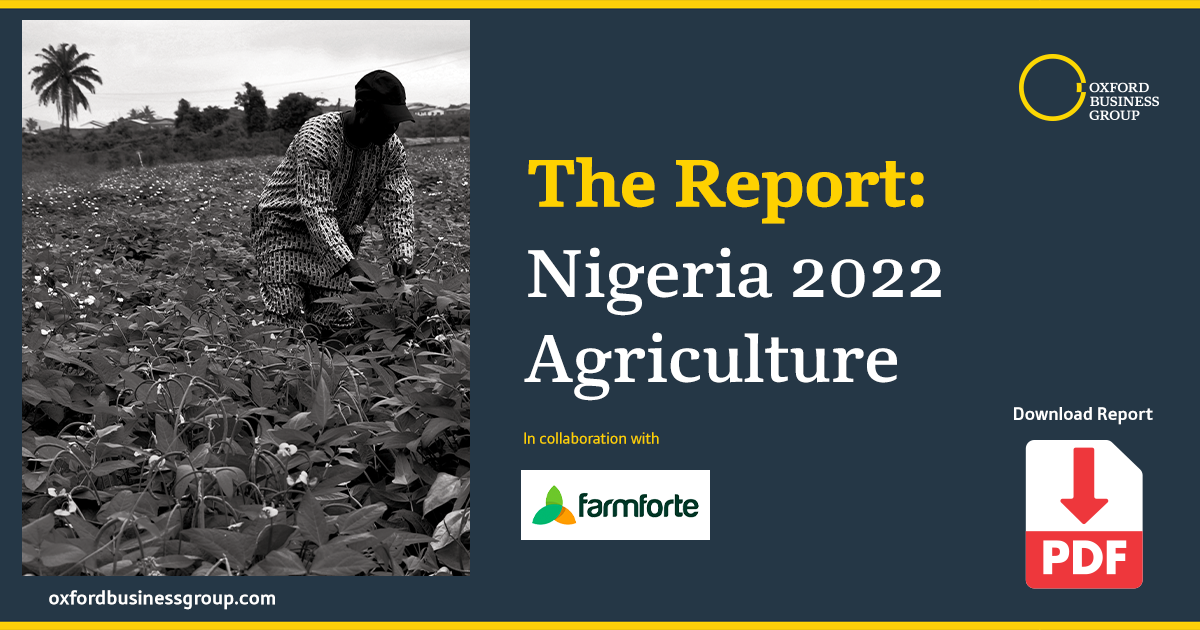How Agriculture Is Boosting Nigeria’s Economy Diversification Plan

By Oxford Business Group
Recent years have seen renewed policy focus on agriculture as an important source of revenue for a diversified Nigerian economy, with plans to revitalise the sector centred on increasing local production and improving the value chain.
The report looks at the key role of agritech in supporting the country’s efforts to ensure food security for its growing population and create a more diversified, industrialised economic base. It also identifies local value-added activities that are ripe for growth, ranging from agro-processing to food and beverage manufacturing.
Plans to revitalise the industry are centred on increasing local production and improving the value chain.
Agriculture played an important role in driving Nigeria’s economic growth prior to the discovery of crude oil in 1956. Indeed, between 1962 and 1968 the main source of foreign exchange was export crops. In more recent times, policy focus has returned to the agriculture sector as an important source of revenue as the country seeks to diversify the economy away from oil.
Following the oil price crash that put Nigeria into a recession in 2016, agriculture was the only sector that demonstrated resilience, growing by around 4.1%, while the oil sector shrank by 13.7%. Despite the sector’s robust performance, however, Nigeria remains vulnerable to food insecurity and is unable to meet domestic demand for food products.
The Covid-19 pandemic has further exacerbated the challenges that were already present in the sector, including limited transport and difficulty accessing credit. Moreover, lockdowns, panic-buying and the inability of farmers to access markets has not only contributed to a hike in food prices, but has also disrupted supply chains. While the federal government has taken several steps to support the sector before and during the Covid-19 crisis, including subsidies and low-interest loans, more remains to be done to increase the productivity of the industry and restore its role as a key contributor to the economy.
ECONOMIC IMPACT: Nigeria’s agriculture sector is vital to combatting food insecurity, stimulating diversification and boosting economic growth. In 2020 the economy experienced a recession due to the pandemic, though there were signs of a recovery in the last quarter. According to the National Bureau of Statistics (NBS), the sector grew by 3.4% year-on year (y-o-y) in the fourth quarter of 2020, up from 1.4% in the preceding quarter. This figure moderated to 2.3% in the first three months of 2021.
Full-year growth in 2020 reached 2.2%, slightly below the 2.4% reported in 2019. In terms of contribution to GDP, the sector accounted for 27% in the
fourth quarter of 2020, while industry and services comprised 18.8% and 54.3%, respectively. The annual contribution of the sector was 24.5% of GDP. Overall, in 2020 agriculture maintained its position as one of the most resilient sectors of the economy, even in the face of external shocks and supply-chain disruptions.
The agriculture sector comprises four subsectors: crop production; livestock; forestry; and fisheries. Crop production accounted for 89.7% of overall nominal sector growth in the fourth quarter of 2020 and 91.4% for the full year, making it the largest segment. Nigeria’s major crops include cassava, sesame, rice, cocoa, palm oil, ginger, tomatoes, groundnut, sorghum, millet and wheat. The country has 34m ha of arable land, with 6.5m of land under permanent crops, and 30.3m ha of land under permanent meadows and pastures. According to the World Bank, the sector accounted for around 35% of employment in 2019, making it the country’s largest employer.
OVERSIGHT & POLICY: The sector is overseen by the Federal Ministry of Agriculture and Rural Development (FMARD) and has a mandate to “ensure food security in crop, livestock and fisheries; stimulate agricultural employment and services; promote the production and supply of raw materials to agro-industries; provide markets for the products of the industrial sector; [and] generate foreign exchange and rural socio-economic development”. FMARD supervises around 50 parastatals operating as departments or agencies, and has its own technical and service departments, which include those responsible for agriculture, fisheries, livestock, fertilisers, food reserve and storage, finance, procurement, planning and cooperatives.
The most important piece of agricultural policy is the Agriculture Promotion Policy, also known as the Green Alternative. The policy is based on the gains of the Agricultural Transformation Agenda – which was launched in 2013 with a view to strengthen the sector – and has the objective of ensuring that there is sufficient output to meet domestic demand and export quality regulations, while setting the agriculture sector on the road to growth.
GROWTH PLAN: In the aftermath of the 2016 recession, the federal government launched the Economic Recovery and Growth Plan (ERGP) 2017-20 to reinvigorate economic growth by diversifying the country’s economic base and creating jobs. With regard to agriculture, the plan makes reference to transforming the sector and ensuring food security, thereby turning Nigeria into an industrialised economy with a particular focus on agro-processing, and food and beverage manufacturing. Over the lifespan of the plan, the agriculture sector was expected to grow at an annual rate of 6.9%, and reduce food imports, boost exports, and achieve self-sufficiency in products such as tomato paste, rice and wheat. However, the sector grew at an average of 2.6% between 2017 and 2019 – less than half the target – and self-sufficiency in the aforementioned crops has yet to be achieved.
There are many policies aimed at revitalising agriculture; however, in recent years government spending has fallen below the target of 10% of total budget allocations set by the Maputo Declaration on Agriculture and Food Security. In 2021, amid the challenges of the pandemic, the sector was allocated less than 2% of the overall budget.
INITIATIVES FOR AGRI-BUSINESS: Intervention programmes aimed at boosting food security and agricultural exports have been implemented by the Central Bank of Nigeria (CBN) and the Bank of Industry (BoI), a development finance institution. Launched in 2015, the Anchor Borrowers’ Programme is a CBN initiative aimed at creating a linkage between smallholder farmers and agro-processors through the provision of financing options and inputs.
The BoI, for its part, has continued to support the sector through the provision of loans aimed at developing the value chain. It is estimated that between 2015 and October 2020 more than 6.9m direct and indirect jobs were created through BoI initiatives. Commercial bank loans to the sector have been on the rise since 2015, but the share of agricultural loans remains small compared to other sectors.
Another programme is the Presidential Fertiliser Initiative (PFI), which seeks to boost farmers’ access to fertilisers and improve crop performance, and was implemented by the Nigeria Sovereign Investment Authority (NSIA) in 2017. In the programme’s first four years of operation the PFI yielded more than 30m 50-kg bags of fertiliser, and saved over $350m on subsidy and import substitution payments. In April 2021 the federal government approved the restructuring of the PFI for another four years.
The NSIA signed agreements with Morocco’s OCP Group – one of the world’s largest producers of phosphate and phosphate-based products – the Akwa Ibom State government; the Nigerian National Petroleum Corporation; the Gas Aggregation Company Nigeria; the Nigerian Content Development and Monitoring Board; Mobil Producing Nigeria, ExxonMobil’s local subsidiary; and the Fertiliser Producers and Suppliers Association of Nigeria for the second phase of the PFI and to the construction of a new ammonia plant. The latter is a $1.4bn project that aims to produce 1.5m tonnes of ammonia per year, 70% of which will be exported to Morocco, while the remaining 30% will be used to produce fertiliser for domestic use. The facility is set to be operational by 2024.
PRODUCTION & TRADE: In the early 1960s Nigeria was the world’s top producer of palm oil, with a global market share of 43%, ahead of Malaysia and Indonesia. Today it is the fifth-largest producer, accounting for less than 2% of total global production. In terms of cocoa production, Nigeria was the second-largest producer in the 1960s, accounting for 18% of the world’s cocoa production, whereas today, the country’s production is estimated at around 5%, behind that of Ghana and Côte d’Ivoire, which have a global market share of 21% and 39%, respectively.
In the fourth quarter of 2020 the total value of trade in agricultural goods reached N588.2bn ($1.5bn), representing 6.5% of overall trade. In the first half of 2021 this figure rose to N1.5trn ($3.7bn). The major traded agricultural products were sesame seeds, cocoa beans and cashew nuts. In 2020 the value of agricultural exports was 19.2% higher than the previous year, while agricultural imports were up 78.6%.
Despite an increase in productivity in some agricultural products, Nigeria’s growing population has had to rely on imported food products to supplement local supply. For instance, even though Nigeria is the largest rice producer on the continent – with production concentrated mainly in Kebbi State and Kaduna State – output has proven insufficient to meet growing domestic demand.
It is estimated that between 2016 and 2019 the country’s cumulative agricultural imports outweighed its agricultural exports by a factor of four, at N3.3trn ($8.2bn), and that it lost up to $10bn in annual export opportunities from groundnut, palm oil, cocoa and cotton, as a result of declining production levels.
In 2019 the government took measures to spur local production and reduce the import bill, such as closing borders to neighbouring countries Benin, Niger and Cameroon to prevent the smuggling of certain cheap crops like rice, as well as poultry. However, in early 2021 the borders with Benin were reopened, and it is reported that the Nigerian market is again seeing substantial inflows of foreign rice. Although the policy resulted in a boost in rice production, experts believe that the country should instead focus on raising the productivity of the sector.
With a view to reducing transport costs and tackling high food prices, the government announced in April 2021 that it plans to cut import duties on tractors and mass-transit vehicles, after inflation reached a four-year high the previous month. To stimulate economic growth, the administration of President Muhammadu Buhari has prioritised investment in rail and road infrastructure, and there are some projects in the pipeline that could play an important role in the development of the agriculture sector.
FOOD PROCESSING: The largest manufacturing sub-sectors in Nigeria are the agro-processing sector, comprising food, beverages and tobacco; followed by light manufacturing, which includes textiles and wood products. The agro-processing subsector accounts for around half of the manufacturing jobs in the country, according to a 2020 report published by the UN Food and Agriculture Organisation (FAO).
The ERGP is based on the Nigeria Industrial Revolution Plan, which has been designed to accelerate industrial capacity through the development of four industry groups – one of which is the agri-business and agro-allied sector. The plan’s objectives include building an integrated value chain, boosting local production to meet local demand and reducing Nigeria reliance on imports of processed food products.
Against this backdrop, and to further develop the sector, the federal government and FMARD have welcomed many initiatives, funded either by international organisations or in collaboration with other governments. Examples include the establishment of 142 agro-processing facilities to boost agricultural production as part of the Nigeria-Brazil Agriculture Mechanisation Programme, and a programme to construct special agro-industrial processing zones (SAPZs) in all 36 Nigerian states. The SAPZ project is set to receive $520m in funding from the African Development Bank and its partners, and $200m from the International Fund for Agricultural Development. It will feature four components: infrastructure devel- opment and agro-industrial management; productivity and production; policy and institutional development; and programme coordination and management. The pilot phase will include the states of Ogun, Oyo, Imo, Cross River, Kano, Kaduna and Kwara.
RECOVERY PLAN: To respond to the challenges caused by the Covid-19 pandemic, the federal government launched the $5.9bn Nigeria Economic Sustainability Plan in mid-2020. Under the plan, one of the key projects aimed at sustaining economic activity, boosting production, maximising jobs and conserving foreign exchange is the Mass Agricultural Programme (MAP). Estimated to cost N634bn ($1.6bn), MAP was designated to span the entire length of the agricultural value chain, from farm to table. Through a multi-layered approach, the plan aimed to bring between 20,000 and 100,000 ha of new farmland under cultivation in every state. Support was provided to smallholder farmers through services and inputs, such as land clearing, ploughing, seeds, fertilisers and pesticides, as well as equipment and storage to mitigate post-harvest losses. The objective of the programme was to create millions of direct and indirect job opportunities over a 12-month period.
The programme also outlined the construction of rural roads to facilitate connectivity to farms. Closer collaboration with the private sector was also targeted to address issues along the agricultural value chain – namely, production, harvesting, storage, transporting, processing and marketing. Notably, however, MAP did not mention the use of technology to increase production and output levels.
In parallel to this, different government agencies have taken steps to mitigate the impact of the crisis on the agriculture sector. For example, through the PFI, the federal government reduced the price of fertilisers from N5500 ($13.75) to N5000 ($12.50) per 50-kg bag. The central bank, for its part, provided funding to businesses in key sectors that were disrupted by the Covid-19 pandemic.
Specifically, it introduced the N50bn ($125m) Targeted Credit Facil- ity, which was made available to companies active in the agriculture value chain, health, hospitality and aviation, as well as to micro-, small and medium-sized enterprises. Other measures aimed at boosting farm- ers’ access to finance include the disbursement of a N75bn ($187.5m) loan-guarantee scheme under the auspices of the Nigeria Incentive-Based Risk-Sharing System for Agricultural Lending.
CHALLENGES: PwC’s “Responding to the impact of Covid-19 on food security and agriculture in Nigeria” report, published in mid-2020, identified seven challenges that the sector faced prior to the pandemic. These include resource shortages, corresponding to limited rainfall and inputs; violent conflict; outdated agriculture systems; lack of access to finance; insufficient supply to meet population growth and food demand; lack of commercialisation; and an absence of value addition and supply-chain linkages.
The outbreak of Covid-19 further exacerbated some of these challenges, with food security becoming a key concern amid supply-chain disruptions and reductions in income. At the same time, food prices increased significantly due to diminished liquidity for traders and lower availability of agricultural labour. According to the NBS, food inflation reached a 12-year high of 23% y-o-y in March 2021, before slowing to 22.3% in May and 17.2% in November. Increases in the prices of bread and cereals; potatoes, yams and other tubers; meat; vegetables; fish; oils and fats; and milk, cheese and eggs were responsible for the rise in the food index in June 2021. Considering that 57% of household incomes in Nigeria are spent on food-related items, the rise of prices in the sector has a significant impact on the income of Nigerians.
SOLUTIONS: In recent years the government has paid particular attention to the agriculture sector, and the CBN has disbursed millions of dollars in loans.
Nevertheless, farms in Nigeria remain characterised by low yields. One possible explanation for this is the fact that smallholder farming represents over 70% of the agri-food supply chain, which makes it difficult to fully mechanise, digitise and automate the sector. This hinders the sector’s productivity and its competitiveness in the global market. “You can buy rice in India, put it on a ship to Lagos Port, offload it and pay a heavy duty – and it still comes out less expensive than locally produced rice,” Dimieari Von Kemedi, founder and managing director of local farming collective Alluvial Agriculture, told international press in October 2020.
SMALLHOLDER COLLECTIVES: According to Von Kemedi, the solution to the sector’s challenges is not to get everyone involved in agriculture, but to unite forces to raise productivity. In this sense, many private sector initiatives – including start-ups – have emerged with the objective of boosting productivity through innovative solutions (see analysis).
Alluvial Agriculture, for example, started working in the oil-rich Niger Delta region, known for its ideal wet conditions to cultivate rice, by focusing on con- tiguous small plots of land owned by thousands of smallholders. According to the FAO, an average farm in Nigeria covers 1.8 ha, but Alluvial Agriculture seeks to group several of them into 500-ha collectives to create economies of scale in order to achieve more competitive prices from buyers – including flour mills, brewers and rice processors – and for the purchase of agricultural inputs such as fertilisers and seeds.
In October 2020 the Mastercard Foundation announced a two-year partnership with Alluvial Agriculture to ensure a sustainable post-Covid-19 recovery of the sector to withstand forthcoming crises such as climate change. The $20.4m grant will give 65,000 Nigerian farmers access to tractors, seeds, fertilisers, finance and advisory services. The partnership hopes to increase rice yields from 2.5 tonnes to 4.5 tonnes per ha, and maize yields from 1.5 tonnes to 4 tonnes. Ultimately, the goal is for the plots in the participating states of Adamawa, Bayelsa, Benue, Delta, Kaduna, Kano, Kebbi and Nasarawa, among others, to be self-sustaining and scalable by the time the funding of the project concludes.
OUTLOOK: The agriculture sector faces many challenges, such as low levels of irrigation, an outdated land tenure system and limited adoption of research findings, which have kept agricultural productivity low, and caused post-harvest losses and waste. There is room to expand and commercialise, however, as Nigeria only makes use of half of its 71m ha of available farmland, and 15m to 30m smallholder farmers produce an estimated 95% agricultural output.
Although there is notable export potential, the country needs to first focus on meeting domestic demand and prioritising the sector as a contributor to economic growth. Nigeria can learn how to optimise its agricultural operations by looking further afield to Brazil, a country that has leveraged innovation to increase domestic production and reduce its reliance on food imports. The South American nation once imported 70% of its food, but has since managed to become one of the world’s top producers.
There is scope for Nigeria to reach the same target. It has the necessary conditions to boost food production in terms of climate, soil, rainfall and topography. Besides the initiatives that have already been implemented by the government aimed at boosting productivity, more can be achieved through the introduction of innovative practices and the adoption of technologies to capitalise on economies of scale and drive the economy towards growth in 2022 and beyond.
Source: Oxford Business Group except Headline





